25 results
Higher education Common Core HSN-Q.A.3 resources for Microsoft Word

Math Placement Exam Review
Math Placement Exam Review
The placement exam is designed to test a student’s knowledge of High School-Level material that is essential to success in MATH. A score of 70% or higher is required to pass the test. Students who score less than 70% will be moved to a section of Basic MATH.
It contains 34 Math questions.
It is 6 pages.
This is a great way to help students review for the PARCC Test.
My Quizzes:
4th Grade Word Problems Quiz (10 Q)
Equations and Inequalities Quiz (20 Question
Subjects:
Grades:
10th - 12th, Higher Education, Adult Education
Types:
CCSS:
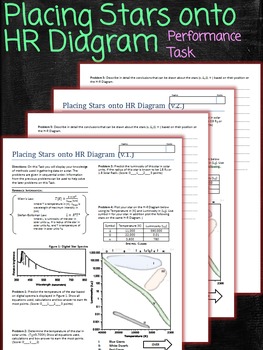
Placing Stars onto H-R Diagram Performance Task
On this task students will display your knowledge of methods used in gathering data on a star. The problems are given in sequential order. Information from the previous problems can be used to help solve the later problems on this task. Students will read infromation from a spectra of a star. Calculate temperature using Weins Law. Calculate the luminosity using Stefan-Boltzman Law and finally place the star on the Hertzsprung-Russel Diagram. Math CC.6.EE Apply and extend previous understandings
Subjects:
Grades:
9th - 12th, Higher Education, Adult Education
Types:

Question Exploration: How Much Does 1+1= In Significant Digits?
How much does 1+1? It can depend on significant digits. This concept comparison contrasts accuracy and precision in measurement, and the question exploration explains how to use all the significant figure rules to make measurements, as well as how to round to the right number of sig figs when using scientific notation. Question Exploration Routine is an instructional methods that teachers can use to help a diverse student population understand a body of content information by carefully answering
Subjects:
Grades:
9th - 12th, Higher Education
Also included in: StayGiant Physics Bundle: Measurement
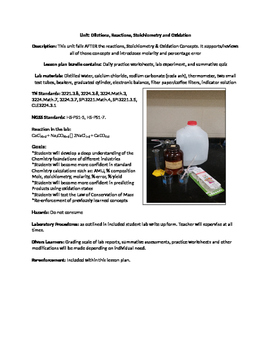
Unit: Stoichiometry of Solutions and Concentrations
This is a full unit, includes review sheets on Molarity and molality designed for homebound students (easily self directed), a lab experiment with an alternate assignment, and 4 versions of a summative quiz. This Unit is designed to fall AFTER Stoichiometry, Nomenclature, types of chemical reactions and oxidation states. It allows for review of all of those concepts. Answer keys are all included.
The lab experiment requires: distilled water, soda ash, calcium chloride, test tubes, test tube ra
Subjects:
Grades:
9th - 12th, Higher Education
Types:
CCSS:
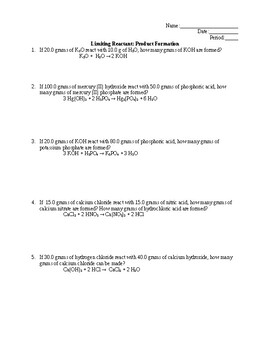
Limiting and Excess Reactant Worksheet
This worksheet helps reinforce concepts from the Limiting and Excess Reactants PowerPoint. This is the fourth worksheet in the scale factor method series. The worksheet can be used with any stoichiometry method, but the answer key shows how to answer the questions using the scale factor approach.The scale factor method is an innovative and intuitive approach to solving stoichiometry problems. Students using this method learn to solve problems much more quickly and successfully than when using di
Subjects:
Grades:
9th - 12th, Higher Education
Types:
NGSS:
HS-PS1-7
Also included in: Limiting and Excess Reactants Bundle
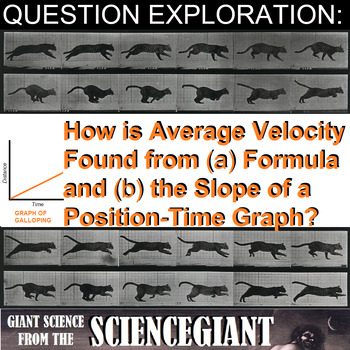
Question Exploration: Solve Average Velocity from a Position-Time Graph
How is average velocity calculated from a position-time graph? This question exploration explains how average velocity can be found as the slope of a displacement-time graph, and gives physics Ss practice solving average velocity as it can be algebraically rearranged into a kinematic equation.Question Exploration Routines are instructional methods that teachers can use to help a diverse student population understand a body of content information by carefully answering a critical question to arri
Subjects:
Grades:
8th - 12th, Higher Education
Also included in: StayGiant Physics Bundle: Kinematics
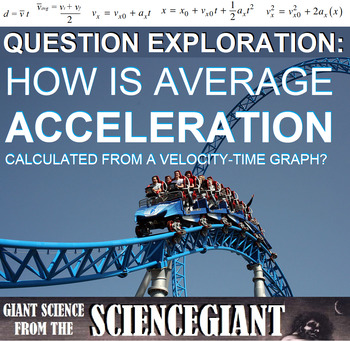
Question Exploration: Solve Average Acceleration from a Velocity-Time Graph
How is average acceleration calculated from a velocity-time graph? This question exploration explains how average acceleration can be found as the slope of a v-t graph, and gives physics Ss practice solving changing velocity as it can be algebraically rearranged into a kinematic equation.Question Exploration Routines are instructional methods that teachers can use to help a diverse student population understand a body of content information by carefully answering a critical question to arrive at
Grades:
9th - 12th, Higher Education
Also included in: StayGiant Physics Bundle: Kinematics
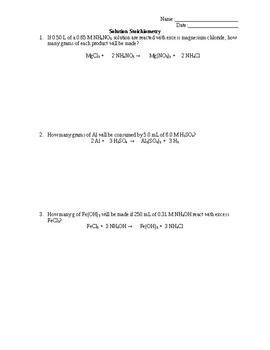
Solution Stoichiometry Worksheet
This worksheet helps reinforce concepts from the Solution Stoichiometry PowerPoint. This is the fifth worksheet in the scale factor method series. The worksheet can be used with any stoichiometry method, but the answer key shows how to answer the questions using the scale factor approach.The scale factor method is an innovative and intuitive approach to solving stoichiometry problems. Students using this method learn to solve problems much more quickly and successfully than when using dimensiona
Subjects:
Grades:
9th - 12th, Higher Education
Types:
NGSS:
HS-PS1-7
Also included in: Solution Stoichiometry Bundle
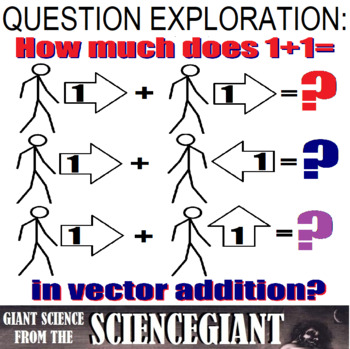
Question Exploration: How Much Does 1+1= In Vector Addition? PART 1
How much does 1+1 equal? 2? 0? 1.414? It depends on how you do vector addition in physics! This question exploration explains definitions, how to distinguish between vectors and scalars, and gives Ss practice adding vectors in one dimension and in two dimensions.Question Exploration Routines are instructional methods that teachers can use to help a diverse student population understand a body of content information by carefully answering a critical question to arrive at a main idea answer. Stude
Subjects:
Grades:
9th - 12th, Higher Education
CCSS:
Also included in: StayGiant Physics Bundle: Measurement

Solution Stoichiometry Bundle
This bundle contains the PowerPoint, worksheet, and key for Solution Stoichiometry using the scale factor method. This is the fifth bundle in the scale factor method series. The worksheet can be used with any stoichiometry method, but the answer key shows how to answer the questions using the scale factor approach.The scale factor method is an innovative and intuitive approach to solving stoichiometry problems. Students using this method learn to solve problems much more quickly and successfully
Subjects:
Grades:
9th - 12th, Higher Education
NGSS:
HS-PS1-7

Percent Yield Bundle
This bundle contains the Percent Yield PowerPoint, as well as two accompanying worksheets and answer keys. One worksheet is mass only, while the second involves solution stoichiometry. This is the sixth bundle in the scale factor method series. The worksheets can be used with any stoichiometry method, but the answer key shows how to answer the questions using the scale factor approach.The scale factor method is an innovative and intuitive approach to solving stoichiometry problems. Students usin
Subjects:
Grades:
9th - 12th, Higher Education
NGSS:
HS-PS1-7
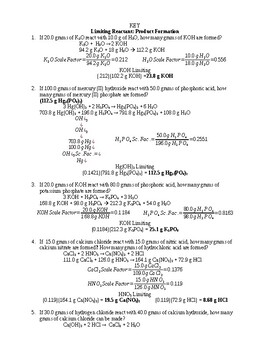
Limiting and Excess Reactants Worksheet Key
This key for the Limiting and Excess Reactants PowerPoint. This is the fourth worksheet in the scale factor method series. The worksheet can be used with any stoichiometry method, but the answer key shows how to answer the questions using the scale factor approach.The scale factor method is an innovative and intuitive approach to solving stoichiometry problems. Students using this method learn to solve problems much more quickly and successfully than when using dimensional analysis. Once you hav
Subjects:
Grades:
9th - 12th, Higher Education
Types:
NGSS:
HS-PS1-7
Also included in: Limiting and Excess Reactants Bundle

Scale Factor Extensions Bundle
This bundle contains the Scale Factor Extensions PowerPoint, worksheet, and accompanying key. This is the seventh bundle in the scale factor method series. It requires calculating gas volumes generated and numbers of particles formed. Excess reactants are clearly defined--students do not need to know the concept of limiting reactant to do this worksheet. The worksheet can be solved using any stoichiometry method, but the key shows how to solve using the scale factor method.The scale factor metho
Subjects:
Grades:
9th - 12th, Higher Education
NGSS:
HS-PS1-7
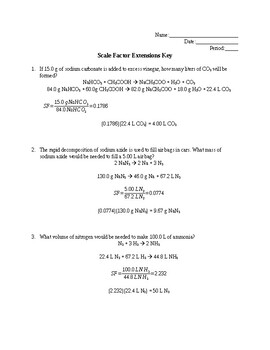
Scale Factor Extensions Worksheet
This worksheet helps reinforce concepts from the Scale Factor Extensions PowerPoint. This is the eighth worksheet in the scale factor method series. It requires calculating gas volumes generated and numbers of particles formed. Excess reactants are clearly defined--students do not need to know the concept of limiting reactant to do this worksheet. The worksheet can be solved using any stoichiometry method, but the key shows how to solve using the scale factor method.The scale factor method is an
Subjects:
Grades:
9th - 12th, Higher Education
Types:
NGSS:
HS-PS1-7
Also included in: Scale Factor Extensions Bundle
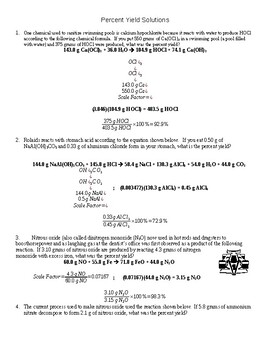
Percent Yield Worksheet Key
The key for the worksheet. This is the sixth worksheet in the scale factor method series. The first half of the worksheet has a clearly defined limiting reactant. In the second half, determining the limiting reactant is part of the process. The worksheet can be used with any stoichiometry method, but the answer key shows how to answer the questions using the scale factor approach.The scale factor method is an innovative and intuitive approach to solving stoichiometry problems. Students using thi
Subjects:
Grades:
9th - 12th, Higher Education
Types:
NGSS:
HS-PS1-7
Also included in: Percent Yield Bundle
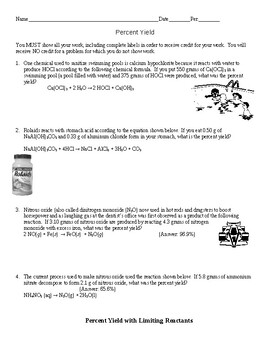
Percent Yield Worksheet
This worksheet helps reinforce concepts from the Percent Yield PowerPoint. This is the sixth worksheet in the scale factor method series. The first half of the worksheet has a clearly defined limiting reactant. In the second half, determining the limiting reactant is part of the process. The worksheet can be used with any stoichiometry method, but the answer key shows how to answer the questions using the scale factor approach.The scale factor method is an innovative and intuitive approach to so
Subjects:
Grades:
9th - 12th, Higher Education
Types:
NGSS:
HS-PS1-7
Also included in: Percent Yield Bundle
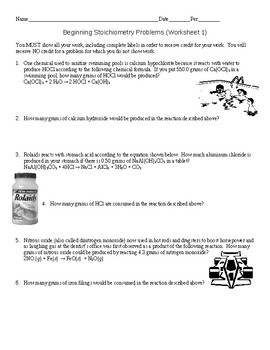
Beginning Stoichiometry Worksheet
The scale factor method is an innovative and intuitive approach to solving stoichiometry problems. Students using this method learn to solve problems much more quickly and successfully than when using dimensional analysis. Once you have used it, you won't want to go back!
Subjects:
Grades:
9th - 12th, Higher Education
Types:
NGSS:
HS-PS1-7
Also included in: Mass-Mass Stoichiometry Bundle
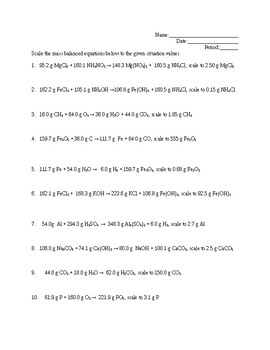
Scaling Chemical Equations Worksheet
This worksheet provides your students with practice to reinforce the concept of scaling chemical reactions using the scale factor method.The scale factor method is an innovative and intuitive approach to solving stoichiometry problems. Students using this method learn to solve problems much more quickly and successfully than when using dimensional analysis.
Subjects:
Grades:
9th - 12th, Higher Education
Types:
CCSS:
NGSS:
HS-PS1-7
Also included in: Scaling Chemical Equations Bundle
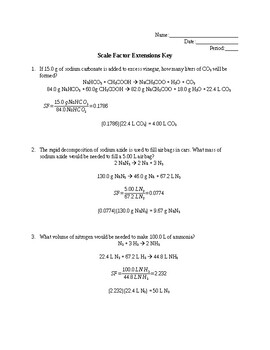
Scale Factor Extensions Worksheet Key
This is the key for Scale Factor Extensions worksheet. This is the eighth worksheet in the scale factor method series. It requires calculating gas volumes generated and numbers of particles formed. Excess reactants are clearly defined--students do not need to know the concept of limiting reactant to do this worksheet. The worksheet can be solved using any stoichiometry method, but the key shows how to solve using the scale factor method.The scale factor method is an innovative and intuitive app
Subjects:
Grades:
9th - 12th, Higher Education
Types:
NGSS:
HS-PS1-7
Also included in: Scale Factor Extensions Bundle
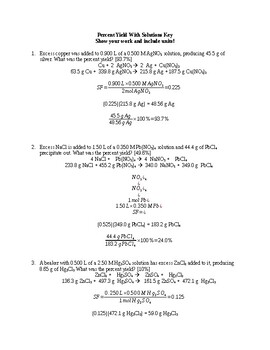
Percent Yield with Solution Stoichiometry Key
The key for the Percent Yield with Solution Stoichiometry Worksheet. This is the key for the seventh worksheet in the scale factor method series. Students will need to have the skills taught in Solution Stoichiometry to complete this worksheet. The first half of the worksheet has a clearly defined limiting reactant. In the second half, determining the limiting reactant is part of the process. The worksheet can be used with any stoichiometry method, but the answer key shows how to answer the ques
Subjects:
Grades:
9th - 12th, Higher Education
Types:
NGSS:
HS-PS1-7
Also included in: Percent Yield Bundle
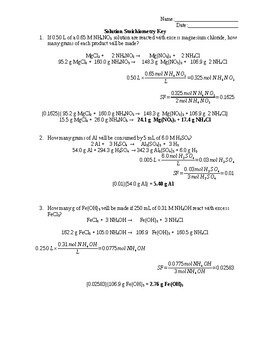
Solution Stoichiometry Key
This key for the Solution Stoichiometry Worksheet. This is the fifth worksheet in the scale factor method series. The worksheet can be used with any stoichiometry method, but the answer key shows how to answer the questions using the scale factor approach.The scale factor method is an innovative and intuitive approach to solving stoichiometry problems. Students using this method learn to solve problems much more quickly and successfully than when using dimensional analysis. Once you have used it
Subjects:
Grades:
9th - 12th, Higher Education
Types:
NGSS:
HS-PS1-7
Also included in: Solution Stoichiometry Bundle
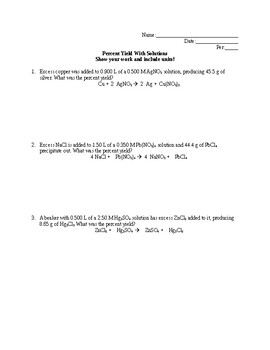
Percent Yield with Solution Stoichiometry Worksheet
This worksheet helps reinforce concepts from the Percent Yield PowerPoint. This is the seventh worksheet in the scale factor method series. Students will need to have the skills taught in Solution Stoichiometry to complete this worksheet. The first half of the worksheet has a clearly defined limiting reactant. In the second half, determining the limiting reactant is part of the process. The worksheet can be used with any stoichiometry method, but the answer key shows how to answer the questions
Subjects:
Grades:
9th - 12th, Higher Education
Types:
NGSS:
HS-PS1-7
Also included in: Percent Yield Bundle

Science/Math - using Nearpod - SIGNIFICANT FIGURES
Are you looking for a tool that can freely supply a student with all the information needed to teach them with very little or no work from you? Well then this is the resource for you. This tool will prompt students with critical thinking exercises and challenges that address key ideas but supply the explanations as well. This teaching device can be provided to students in a full class forum or can be assigned as independent study. The following lesson is one of many to engage students in the ent
Subjects:
Grades:
9th - 12th, Higher Education
Types:
CCSS:

AP Biology Remote Lab Metric System
Remote lab for pandemic use.Lab 1 in a series for college freshman biology using a cheap lab kit which can be shipped to students. Developed in May 2020.
Subjects:
Grades:
12th, Higher Education
Types:
Showing 1-24 of 25 results

